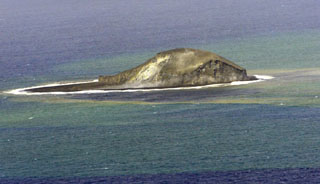Report on Home Reef (Tonga) — 30 April-6 May 2025
Smithsonian Institution / US Geological Survey
Weekly Volcanic Activity Report, 30 April-6 May 2025
Managing Editor: Sally Sennert.
Please cite this report as:
Global Volcanism Program, 2025. Report on Home Reef (Tonga) (Sennert, S, ed.). Weekly Volcanic Activity Report, 30 April-6 May 2025. Smithsonian Institution and US Geological Survey.
Home Reef
Tonga
18.992°S, 174.775°W; summit elev. -10 m
All times are local (unless otherwise noted)
The Tonga Geological Services reported continuing activity at Home Reef with lava effusion and explosive activity at the main vent. A cone had grown around the vent and was 50-100 m high, based on a 26 April satellite image, and the vent had enlarged to about 175 m by 135 m in dimension. New deposits of material were visible on the W and SW flanks, nearly covering the lava lobes emplaced in November and December 2024. A volcanic ash plume was identified in a satellite image at 1354 on 29 April. In a 1 May image steam plumes rose from the vent and water around the island was discolored. Moderate thermal anomalies continued to be detected by the Middle InfraRed Observation of Volcanic Activity (MIROVA) system at least through 3 May. The island was about 540 m N-S and 440 m W-E. According to the Wellington VAAC intermittent, low-level ash plumes were visible in satellite images and sometimes observed by pilots during 29-30 April and on 3 May rising 0.9-1.2 km (3,000-4,000 ft) a.s.l. and drifting N, NW, W, and SW. The Aviation Color Code remained at Orange (the second highest level on a four-level scale), the Maritime Alert Level remained at Orange (the third level on a four-level scale), and mariners were advised to stay at least 2 nautical miles (3.7 km) away from the island. The Alert Level for residents of Vava’u and Ha’apai remained at Green (the first level on a four-level scale).
Geological Summary. Home Reef, a submarine volcano midway between Metis Shoal and Late Island in the central Tonga islands, was first reported active in the mid-19th century, when an ephemeral island formed. An eruption in 1984 produced a 12-km-high eruption plume, large amounts of floating pumice, and an ephemeral 500 x 1,500 m island, with cliffs 30-50 m high that enclosed a water-filled crater. In 2006 an island-forming eruption produced widespread dacitic pumice rafts that drifted as far as Australia. Another island was built during a September-October 2022 eruption.
Sources: Tonga Geological Services, Government of Tonga, Wellington Volcanic Ash Advisory Center (VAAC)

